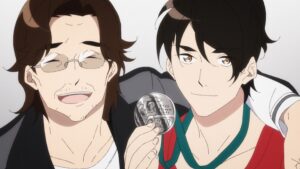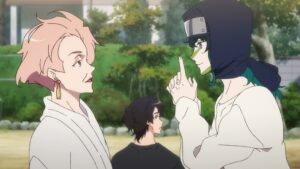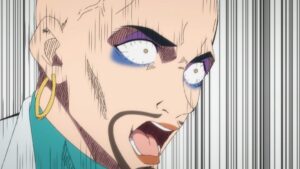I may have jumped the gun on this one, y’all. Taiso Samurai’s first episode was so strange that I couldn’t help but root for it, but the second one’s weirdness was of a less fun variety. Personally, I’d take ‘rooftop chase scene between wannabe ninja and three secret agents’ over ‘transgender acupuncturist chews scenery’ any day of the week. Jotaro’s hastily conceived training menus were kind of funny here, and the introduction of a temporary antagonist in Tetsuo might give the show a little spark next week, but I bought very little of what this episode was selling. (There’s one exception to my disappointment, but we’ll get to that in a bit.) I signed up to blog this on an episodic basis, but unless it can wow me again before we reach, say, mid-November, there’s a better than decent chance it’ll end up dropped.
One of the baseline reasons for my negativity involves the show’s visuals. Put simply, they’re not good. Environments like the Aragaki household and Mari’s bar in Ikebukuro are sparsely decorated, and the series doesn’t take advantage of that open space by moving its characters about the screen. There’s a feeling of artificiality to the whole show, which certainly isn’t helped by its use of glorified clipart. The doors, chairs, tables and couches on display here weren’t designed with Taiso Samurai in mind – they were gathering dust in a digital library long before this show left pre-production. These sorts of preexisting assets are one of modern anime’s most aggressive tumors, so this series is hardly alone in relying on them, but it’s rather obvious about it all the same. The animation is lacking as well (even during a gymnastics-free week), but I could overlook that issue if not for the lame set design and decoration.
Alright, let me talk about the thing in this episode that I liked. Near the very end, when Jotaro begs Amakusa to become his coach again, the older man lays out all the reasons he shouldn’t bring him back on board. At 29, Jotaro is basically a fossil in the gymnastics world, plus he’s got a busted shoulder and his reputation is in the gutter. Amakusa agrees to coach him again, but clearly isn’t shooting for another Olympic medal – he’s doing this out of affection for his student, in the hopes of prolonging his career by just a couple years. Jotaro accepts these terms immediately, which I found very refreshing. When you compare this realistic goal to the world-dominating ambitions of many sports anime coaches (Munakata from Ace wo Nerae and Victor from Yuri on Ice come to mind), Taiso Samurai’s approach feels like a novelty. It’s restrained, maybe even mature – which puts it in another universe from the rest of the show.
I wouldn’t still be watching anime if I couldn’t handle a dash of immaturity here and there. Hell, some of my favorites positively revel in their juvenility, FLCL and Space Dandy being chief among them. But the episode-spanning plotline of Leo working at Mira’s bar, meeting a flamboyant acupuncturist named Britney, then recommending her services to the injured Jotaro was too much for me. It was ridiculous at every turn, from Leo’s ninja headwear to Britney’s aggressive personality to the mid-city Tai chi sequence (which was supposed to be shorthand for Jotaro’s healing process). I got some Kenji Nakamura vibes from that last part, but without any of the meditative qualities or good-naturedness of his radio calisthenics scenes. In Taiso Samurai, we jump straight from, “Isn’t it weird to be doing this in public?” to, “Hey, my shoulder feels great!” so the awkwardness is never truly resolved. Jotaro doesn’t seem to learn anything about focus or acceptance before asking Amakusa for another shot, which kind of hurt the episode’s conclusion.
The real conclusion, though, was the introduction of Tetsuo Minamino, a high school prodigy who seems like Japan’s best hope at another Olympic gymnastics medal. The TV interview from the cold open marked him as a single-minded competitor, as well as a bit of a wet blanket. In other words, he’s the no-nonsense character in a nonsensical show, and he’s not standing for any of it. Marching up to the main character and calling him an embarrassment is an effective way to reveal your antagonist status for sure – or it would be, if Tetsuo didn’t factor heavily into the show’s promotional material and opening sequence. It’s more likely that he’ll be the Yuri Plisetsky of the show, as a rival and eventual friend to Jotaro. Gymnastics being a team sport, Taiso Samurai might do one better and put them on the same squad in an upcoming event. My wish for his character in the short term, though, is to give the show some clear direction by acting as a legitimate obstacle, instead of just a teenage jerk. If the series can manage that, it might be able to recapture my interest in week 3.





The sports career (or the end and lack of it) is the interesting part of this series that could have potential, maybe combined with the relationship Jotaro has with his daughter. But I was already annoyed by the forced bizarreness in epsiode 1. The whole ninja part, over-acting friends, the bird and everything else that’s awkward doesn’t match the down-to-earth vibes of the main plot at all and I don’t understand why this was done.
It feels like one of those cases in which the writer was afraid people might get bored by a decent character-story with a more realistic approach, so they come up with a bunch of nonsense to anime-it-up but I never saw this work out properly. People who want it awkward won’t watch this series to begin with.
The mix is quite unfortunate, because I feel like the calm part of this series could be so good without all that noise.
It comes off as hoping for lightning to strike twice since this staff was involved previously in Zombieland Saga (another mishmash of genres mixed together with forced bizarreness), swapping out zombies and idols, with whatever the hell they’re trying to do with athletics and family drama.